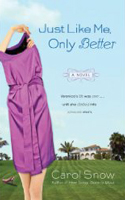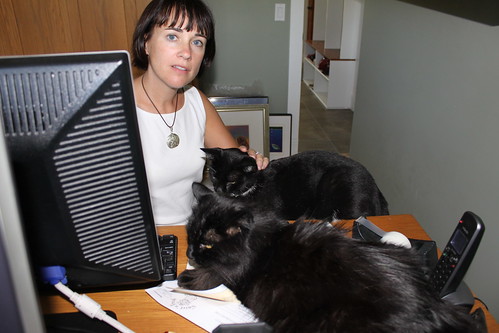
Please give Isla a warm welcome.
Much of the writing of Come Sunday took place in the spare room closet of a 1920s parsonage. On the rod above my computer monitor hung a few of my husband’s denim shirts. On the top shelf were several handmade Tongan quilts we’d received as gifts while living in Hawaii, and a wildly colorful afghan crocheted by a great-granny – much loved, but too scratchy to use.
The closet suited me well, mirroring my secret activity. Apart from my husband and a close friend, nobody knew I spent hours following the life of Abbe Deighton. I’d go into my little closet, close my eyes and she would appear to me, every bit as compelling as the first night she materialized at my bedside. Many times I felt I was recording her story rather than writing it, and as the words piled up, I was both exhilarated and terrified.
Last year we moved from the quaint little cottage to our own home in the hills. It’s situated on a couple of acres, surrounded by Live Oak, Walnut and Pine trees, and it faces the majestic San Gabriel Mountains. The house has enough room for me to claim my own office. Requisite bookshelves line one wall, and against the other is my desk, strewn with scraps of paper and post-it notes and fairy figurines and dozens of things which belong some place else. There’s a window seat with a view of the garden, and a picture of Kjell Sandved’s alphabet on butterfly wings behind my chair. If that isn’t enough to inspire me, there’s a framed promise from a long-ago prophet about there being a plan for my life, a future filled with hope.
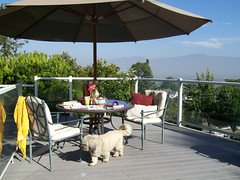
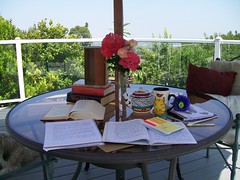
Thanks, Isla, for sharing your space with us.
About the Author:
Isla Morley grew up in South Africa during apartheid, the child of a British father and fourth-generation South African mother. During the country’s State of Emergency, she graduated from Nelson Mandela Metropolitan University in Port Elizabeth with a degree in English Literature.
She has lived in some of the most culturally diverse places of the world, including Johannesburg, London and Honolulu. Now in the Los Angeles area, she shares a home with her husband, daughter, two cats, a dog and a tortoise. Check out her Facebook page.
Giveaway details:
1 copy to a US/Canada reader
1. Leave a comment on this post with an email
2. Tweet, Facebook, etc. and leave a link for a second entry.
Deadline is Sept. 3, 2010 at 11:59PM EST







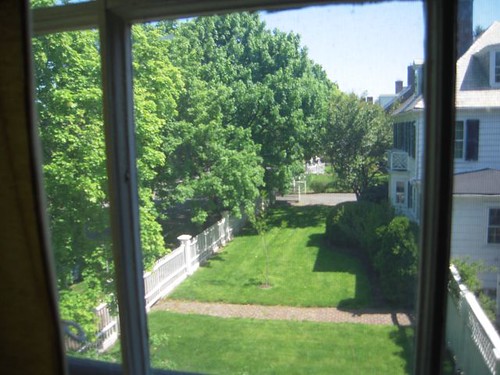 My writing space is a second floor ex-bedroom with maps from very old
My writing space is a second floor ex-bedroom with maps from very old 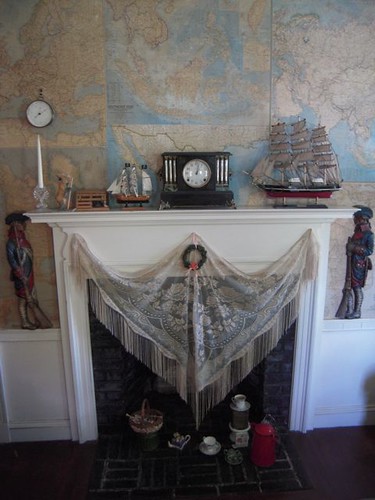 I cleaned up the clutter a bit before I took these photos. When I’m writing a book, I tend to collect anything that I think might be useful to read or look at or to meditate upon, and I have found many items along the way. I have been collecting things for
I cleaned up the clutter a bit before I took these photos. When I’m writing a book, I tend to collect anything that I think might be useful to read or look at or to meditate upon, and I have found many items along the way. I have been collecting things for 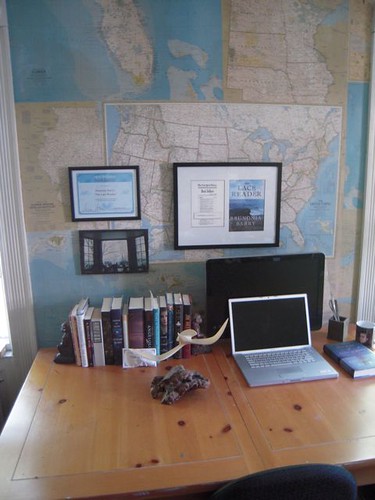 I write directly on the computer and have two of them (both Apples but one a
I write directly on the computer and have two of them (both Apples but one a 






 For my creative writing, I use the large chair and ottoman up in my sitting room. I have a fireplace for when it’s cold (I turn it on with a switch <g>), I have a mini-fridge for my Diet Dr. Pepper (I’m addicted), and a little bar area for my coffee maker. My bookshelves on both sides of the fireplace are for my keeper books and books I’ve not yet read, and the small black bookshelf next to my chair is for the reference books for my current work-in-progress. Right now they’re filled with books about Charleston, its gardens, houses, and ghosts since I’m working on book three in my
For my creative writing, I use the large chair and ottoman up in my sitting room. I have a fireplace for when it’s cold (I turn it on with a switch <g>), I have a mini-fridge for my Diet Dr. Pepper (I’m addicted), and a little bar area for my coffee maker. My bookshelves on both sides of the fireplace are for my keeper books and books I’ve not yet read, and the small black bookshelf next to my chair is for the reference books for my current work-in-progress. Right now they’re filled with books about Charleston, its gardens, houses, and ghosts since I’m working on book three in my  Please note the wideness of the chair. I had a smaller chair but my writing companion (aka Velcro Dog) couldn’t fit in it with me. Since he insists on pressing against my side while I write, I had to accommodate him by buying a larger chair. Sigh. I guess being always in my sight is the reason why I’ve written him into the Tradd Street series as the protagonist’s dog, General Lee.
Please note the wideness of the chair. I had a smaller chair but my writing companion (aka Velcro Dog) couldn’t fit in it with me. Since he insists on pressing against my side while I write, I had to accommodate him by buying a larger chair. Sigh. I guess being always in my sight is the reason why I’ve written him into the Tradd Street series as the protagonist’s dog, General Lee. It’s not glamorous or exotic. Especially since when I’m at home writing I dress like a candidate for What Not to Wear. Notice how I didn’t share any pictures of me actually writing.
It’s not glamorous or exotic. Especially since when I’m at home writing I dress like a candidate for What Not to Wear. Notice how I didn’t share any pictures of me actually writing. 

 I hope you’re enjoying
I hope you’re enjoying 
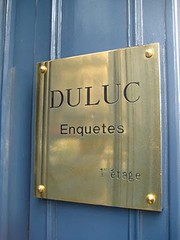
 ***
*** Earlier today, I reviewed
Earlier today, I reviewed  Ten years ago when we moved into our current home, it had a perfect writing room on the second story, with large windows that looked out over the treetops to the faraway hills. A perfect writing space… except for the narrow hallway leading to it, too narrow to get my big desk through. I was heartbroken. My mom gave me two tables that she no longer wanted, and I installed these in my writing room instead — one for my computer, one for handling correspondence, bill paying, all the other stuff.
Ten years ago when we moved into our current home, it had a perfect writing room on the second story, with large windows that looked out over the treetops to the faraway hills. A perfect writing space… except for the narrow hallway leading to it, too narrow to get my big desk through. I was heartbroken. My mom gave me two tables that she no longer wanted, and I installed these in my writing room instead — one for my computer, one for handling correspondence, bill paying, all the other stuff. My theory is to make the room as welcoming and comfortable as possible, to trick myself into working longer hours! Above one desk, I have a painting by my husband that I love, “Tree of Life,” all greens and golds. That big mound of paper on the corner of the desk is a draft of my second novel. I feel guilty looking at it every day that I don’t get back to it. My computer desk has a stand for my handwritten first drafts. I learned long ago that buying expensive moleskin notebooks made me feel like I couldn’t make mistakes, so I have a closet of cheap notepads to write on. The shades are usually half drawn since the light is bright in this room, but I love to look out while I’m thinking. There’s a big sour cherry tree outside, and this time of year wild parrots, green with a single big red spot on their heads, descend on it, bouncing on the branches and squawking as they eat the fruit.
My theory is to make the room as welcoming and comfortable as possible, to trick myself into working longer hours! Above one desk, I have a painting by my husband that I love, “Tree of Life,” all greens and golds. That big mound of paper on the corner of the desk is a draft of my second novel. I feel guilty looking at it every day that I don’t get back to it. My computer desk has a stand for my handwritten first drafts. I learned long ago that buying expensive moleskin notebooks made me feel like I couldn’t make mistakes, so I have a closet of cheap notepads to write on. The shades are usually half drawn since the light is bright in this room, but I love to look out while I’m thinking. There’s a big sour cherry tree outside, and this time of year wild parrots, green with a single big red spot on their heads, descend on it, bouncing on the branches and squawking as they eat the fruit.

